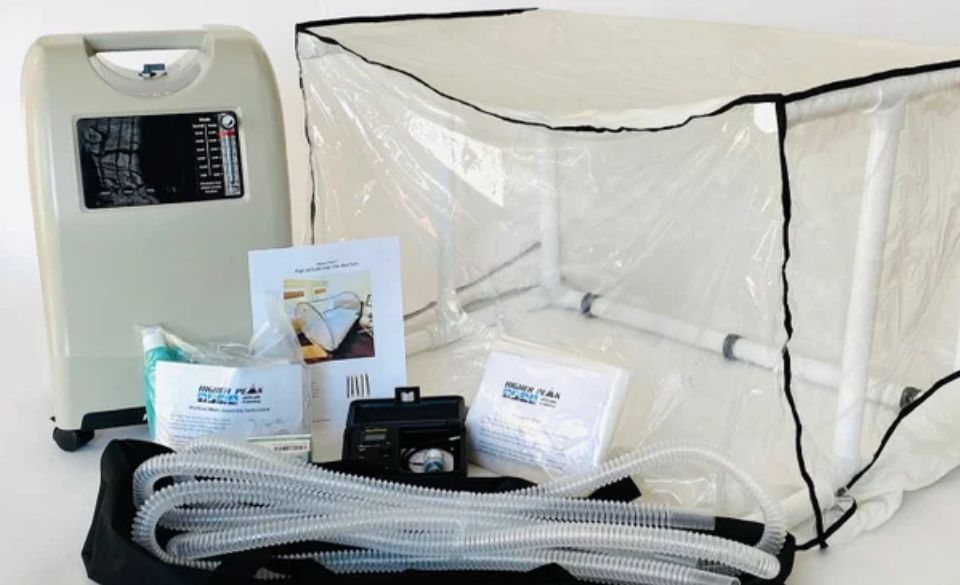
Altitude Tent for Runners: An Effective Training Tool?
Page Contents
As a runner, you may have heard of altitude training and its potential benefits in improving performance. However, not everyone has access to high altitude environments for training. This is where altitude tents come in as an alternative training tool. In this article, we will explore the science behind altitude tents and their potential benefits for runners.
How Altitude Tents Work
Altitude tents are designed to simulate high altitude conditions, allowing individuals to train at a lower oxygen concentration than what is available at sea level. The tents work by lowering the concentration of oxygen in the air that the individual is breathing. The air inside the tent is controlled to mimic the oxygen levels found at high altitudes, which are typically between 6,000 and 16,000 feet above sea level.
When an individual is exposed to high altitude conditions, their body adapts to the lower oxygen levels by producing more red blood cells. Red blood cells carry oxygen to the muscles, and an increase in their number means that more oxygen can be delivered to the muscles during exercise. This adaptation can result in improved endurance, better oxygen utilization, and increased efficiency in the cardiovascular system.
Altitude tents can provide similar benefits as training at high altitudes, but without the risks associated with actually living at high altitudes, such as dehydration, sun exposure, and increased risk of injury. This allows for a safer and more controlled training environment. The tents can also be used by individuals who do not have access to high altitude environments for training.
Benefits of Altitude Tents for Runners
Altitude tents offer several potential benefits for runners. One of the main advantages is improved endurance and performance. By training in a low-oxygen environment, the body adapts by producing more red blood cells, which carry oxygen to the muscles. This increase in oxygen delivery can result in improved endurance, better oxygen utilization, and increased efficiency in the cardiovascular system.
Studies have shown that altitude tent training can lead to significant improvements in running performance. For example, a study published in the Journal of Applied Physiology found that runners who used altitude tents for four weeks improved their time to exhaustion during high-intensity exercise by 27%. Other studies have also found improvements in oxygen uptake, running economy, and time to exhaustion.
Another benefit of altitude tent training is the ability to train at a high altitude without the risks associated with actually living at high altitudes. This allows for a safer and more controlled training environment. Training at high altitudes can cause dehydration, sun exposure, and increased risk of injury, which can be mitigated by using an altitude tent instead.
Using an altitude tent can also provide a psychological advantage by boosting confidence and mental toughness. When an athlete knows they have trained in a low-oxygen environment and adapted to the conditions, they may feel more confident in their ability to perform at high altitudes during competitions.
Overall, altitude tents can be a valuable tool for runners looking to improve their endurance and performance. However, it is important to use them safely and under the guidance of a medical professional to avoid any potential risks or negative effects. With proper use, altitude tents can provide a safe and effective way to simulate high altitude conditions and improve running performance.
Choosing and Using an Altitude Tent
Choosing and using an altitude tent can be a valuable tool for athletes looking to improve their endurance and performance. Here are some factors to consider when choosing and using an altitude tent:
1. Altitude range: Altitude tents can simulate various altitudes, ranging from 6,000 to 16,000 feet above sea level. It is important to choose an altitude range that is appropriate for your training goals and fitness level.
2. Tent size: Altitude tents come in various sizes to accommodate different room sizes and preferences. Make sure to choose a tent size that fits your space and allows for comfortable sleeping arrangements.
3. Airflow: Good airflow is essential for an effective altitude training experience. Make sure the tent is equipped with a ventilation system that can help regulate temperature and humidity levels.
4. Safety precautions: Altitude training can carry some risks, so it is important to take safety precautions when using an altitude tent. Gradually increase exposure to the low-oxygen environment and monitor for symptoms of altitude sickness, such as headache, nausea, and dizziness.
5. Consistency: Consistency is key for effective altitude training. It is recommended to use an altitude tent for several weeks at a time to allow the body to adapt to the low-oxygen environment and see improvements in endurance and performance.
6. Proper maintenance: Proper maintenance of the altitude tent is essential for its longevity and effectiveness. Make sure to follow the manufacturer’s instructions for use and cleaning.
7. Medical advice: It is important to consult with a medical professional before using an altitude tent, especially if you have any pre-existing medical conditions or are unsure about the potential risks of altitude training.
Overall, choosing and using an altitude tent can be a valuable tool for runners looking to improve their endurance and performance. By considering the altitude range, tent size, airflow, safety precautions, consistency, proper maintenance, and medical advice, athletes can effectively use an altitude tent to simulate high altitude conditions and improve their running performance.
Incorporating Altitude Tent Training into Your Running Routine
Incorporating altitude tent training into your running routine can provide several benefits, as demonstrated by numerous studies.
One study published in the Journal of Applied Physiology found that altitude tent training improved the time to exhaustion during high-intensity exercise by 27%, as well as increased oxygen uptake and running economy. Another study published in the International Journal of Sports Physiology and Performance found that altitude tent training resulted in significant improvements in 5k race time.
Incorporating altitude tent training into your running routine can also lead to physiological adaptations such as increased red blood cell production and improved oxygen delivery to the muscles. A study published in the Journal of Strength and Conditioning Research found that altitude training led to an increase in red blood cell count and hemoglobin levels, which can improve endurance and performance.
To effectively incorporate altitude tent training into your running routine, it is recommended to start with shorter exposure times at a lower altitude and gradually increase exposure time and altitude as your body adapts. It is also important to maintain consistency in training to see the full benefits of altitude training.
In addition to altitude tent training, it is also important to continue with regular running workouts to maintain running-specific fitness and technique.
Summary
Altitude tents are an effective tool for athletes looking to improve their endurance and performance. By simulating high-altitude conditions, altitude tent training can lead to physiological adaptations such as increased red blood cell production and improved oxygen delivery to the muscles. Several studies have demonstrated the benefits of altitude tent training, including improvements in time to exhaustion, oxygen uptake, running economy, and race performance. To effectively incorporate altitude tent training into a running routine, it is important to start with shorter exposure times at a lower altitude and gradually increase exposure time and altitude as the body adapts. Consistency in training is also crucial to see the full benefits of altitude training. It is recommended to consult with a medical professional before using an altitude tent, especially if there are any pre-existing medical conditions.
References:
1. Stray-Gundersen J, Chapman RF, Levine BD. “Living high-training low” altitude training improves sea level performance in male and female elite runners. J Appl Physiol. 2001 Oct;91(4):1113-20.
2. Saunders PU, Pyne DB, Gore CJ. Endurance training at altitude. High Alt Med Biol. 2009 Winter;10(4):135-48.
3. Saunders PU, Telford RD, Pyne DB, Cunningham RB, Gore CJ, Hahn AG, Hawley JA. Short-term plyometric training improves running economy in highly trained middle and long distance runners. J Strength Cond Res. 2006 Nov;20(4):947-54.
4. Saunders PU, Garvican-Lewis LA, Chapman RF, Slattery KM, Gore CJ. Improved running economy and increased hemoglobin mass in elite runners after extended moderate altitude exposure. J Sci Med Sport. 2014 Mar;17(2):191-5.
5. Levine BD, Stray-Gundersen J. “Living high-training low”: effect of moderate-altitude acclimatization with low-altitude training on performance. J Appl Physiol. 1997 Aug;83(2):102-12.
6. Gore CJ, Sharpe K, Garvican-Lewis LA, Saunders PU, Humberstone CE, Robertson EY, et al. Altitude training and haemoglobin mass from the optimised carbon monoxide rebreathing method determined by a meta-analysis. Br J Sports Med. 2013 Sep;47 Suppl 1:i31-9.



